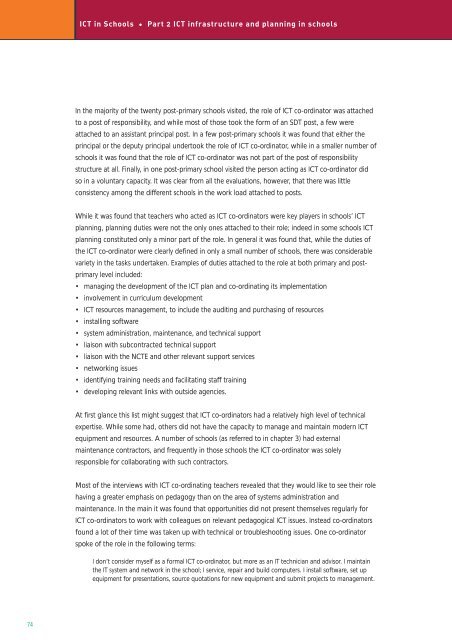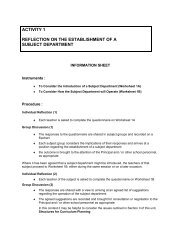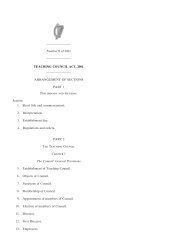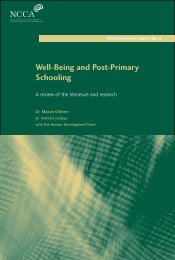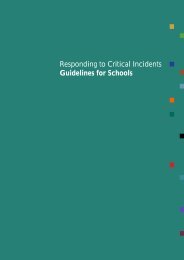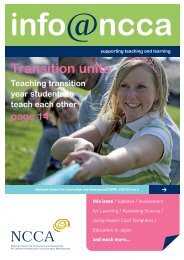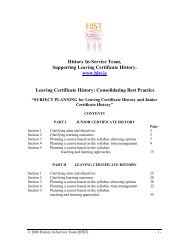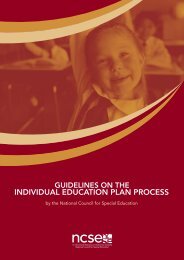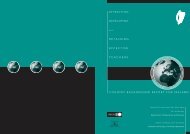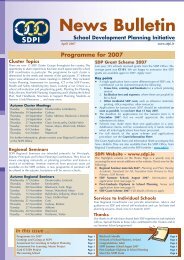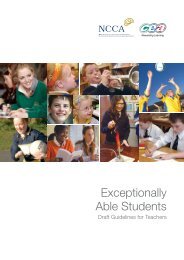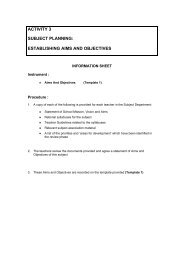ICT in Schools - Department of Education and Skills
ICT in Schools - Department of Education and Skills
ICT in Schools - Department of Education and Skills
You also want an ePaper? Increase the reach of your titles
YUMPU automatically turns print PDFs into web optimized ePapers that Google loves.
Evaluation methods Chapter 2<br />
Dur<strong>in</strong>g the visits to schools the <strong>in</strong>spectors also adm<strong>in</strong>istered a questionnaire to students. The<br />
purpose <strong>of</strong> this questionnaire was to determ<strong>in</strong>e the views <strong>of</strong> students on <strong>ICT</strong>, not only with regard<br />
to their <strong>in</strong>teraction with <strong>ICT</strong> <strong>in</strong> school but also with regard to their use <strong>of</strong> <strong>ICT</strong> outside school time.<br />
For primary schools an entire fifth class was selected for participation, while for post-primary schools<br />
an entire Leav<strong>in</strong>g Certificate year 1 class was selected. It was decided to select fifth-class students <strong>in</strong><br />
primary schools because it was thought that this group would have enough experience <strong>of</strong> <strong>ICT</strong> <strong>in</strong> the<br />
school to be able to give <strong>in</strong>formative feedback; this age group was also considered to be mature<br />
enough to respond to such formal approaches as <strong>in</strong>terviews <strong>and</strong> questionnaires. At the post-primary<br />
level, Leav<strong>in</strong>g Certificate year 1 students were selected because at that po<strong>in</strong>t <strong>in</strong> their school<strong>in</strong>g they<br />
would have had three or four years’ experience <strong>of</strong> <strong>ICT</strong> <strong>in</strong> their school <strong>and</strong> so were considered to be<br />
<strong>in</strong> a position to give <strong>in</strong>formed responses to questions. A total <strong>of</strong> 437 primary students <strong>and</strong> 450 postprimary<br />
students completed questionnaires. Reference is made to the f<strong>in</strong>d<strong>in</strong>gs <strong>of</strong> this survey <strong>of</strong><br />
students throughout this report.<br />
2.6 Observations dur<strong>in</strong>g classroom <strong>in</strong>spections<br />
(primary) <strong>and</strong> subject <strong>in</strong>spections (postprimary)<br />
Dur<strong>in</strong>g the period <strong>in</strong> which case-study schools were be<strong>in</strong>g visited by <strong>in</strong>spectors (October 2005 to<br />
February 2006), the majority <strong>of</strong> the <strong>in</strong>spectors who were engaged <strong>in</strong> evaluative work <strong>in</strong> ma<strong>in</strong>stream<br />
primary <strong>and</strong> post-primary schools completed an “<strong>ICT</strong> review schedule” for each school they<br />
visited. 24 These schools were not a subset <strong>of</strong> the schools that participated <strong>in</strong> the survey <strong>of</strong> primary<br />
<strong>and</strong> post-primary pr<strong>in</strong>cipals <strong>and</strong> teachers but were simply those selected for evaluation as part <strong>of</strong> the<br />
cont<strong>in</strong>u<strong>in</strong>g work <strong>of</strong> the Inspectorate <strong>in</strong> the period <strong>in</strong> question. The <strong>ICT</strong> review schedules used by the<br />
<strong>in</strong>spectors were a means <strong>of</strong> gather<strong>in</strong>g first-h<strong>and</strong> <strong>in</strong>formation on the use <strong>of</strong> <strong>ICT</strong> <strong>in</strong> those schools,<br />
particularly with regard to teach<strong>in</strong>g <strong>and</strong> learn<strong>in</strong>g <strong>in</strong> the classroom.<br />
2.6.1 Primary schools<br />
The <strong>ICT</strong> review schedule used by <strong>in</strong>spectors at primary level conta<strong>in</strong>ed three sections. The first two<br />
sections were identical <strong>and</strong> were to be completed <strong>in</strong> respect <strong>of</strong> two <strong>in</strong>dividual ma<strong>in</strong>stream class<br />
teachers. The third section was to be completed <strong>in</strong> relation to the work <strong>of</strong> a member <strong>of</strong> the specialeducation<br />
team <strong>in</strong> a school (for example the resource teacher, the learn<strong>in</strong>g-support teacher or the<br />
resource teacher for Travellers). The first part <strong>of</strong> each <strong>of</strong> the three sections <strong>in</strong> the schedule required<br />
<strong>in</strong>spectors to ask questions <strong>of</strong> the <strong>in</strong>dividual teacher relat<strong>in</strong>g to their <strong>ICT</strong> plann<strong>in</strong>g <strong>and</strong> their use <strong>of</strong><br />
<strong>ICT</strong>. The second part <strong>of</strong> each section asked <strong>in</strong>spectors to observe <strong>and</strong> evaluate the level <strong>of</strong><br />
<strong>in</strong>tegration <strong>of</strong> <strong>ICT</strong> <strong>in</strong> teach<strong>in</strong>g <strong>and</strong> learn<strong>in</strong>g dur<strong>in</strong>g the <strong>in</strong>spection period with that teacher.<br />
24 In the course <strong>of</strong> their work, <strong>in</strong>spectors undertake WSEs <strong>in</strong> both primary <strong>and</strong> post-primary schools. These evaluations are usually<br />
conducted by <strong>in</strong>spectors work<strong>in</strong>g <strong>in</strong> teams. In addition—<strong>and</strong> although subject <strong>in</strong>spections form part <strong>of</strong> the WSE process <strong>in</strong> a postprimary<br />
school—<strong>in</strong>spectors also undertake separate subject <strong>in</strong>spections <strong>in</strong> post-primary schools.<br />
27


